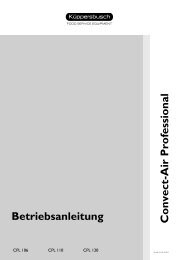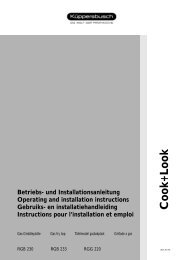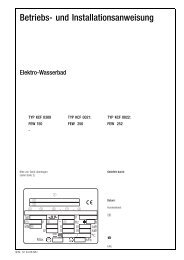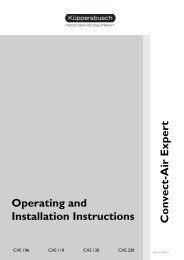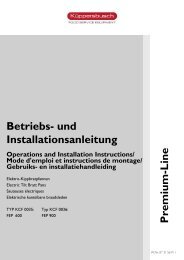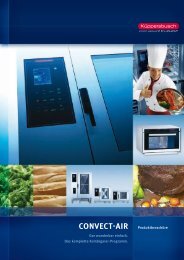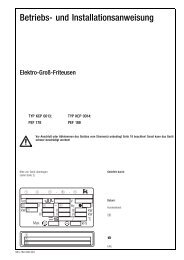Betriebs- und Installationsanweisung Operating and Installation ...
Betriebs- und Installationsanweisung Operating and Installation ...
Betriebs- und Installationsanweisung Operating and Installation ...
Sie wollen auch ein ePaper? Erhöhen Sie die Reichweite Ihrer Titel.
YUMPU macht aus Druck-PDFs automatisch weboptimierte ePaper, die Google liebt.
<strong>Installation</strong> instructions<br />
<strong>Installation</strong> instructions<br />
Safety instructions<br />
- The electrical installation <strong>and</strong> connection should only be carried out<br />
by a fully qualified electrical fitter who has been examined by the<br />
local electricity supply company. The statutory regulations <strong>and</strong> the<br />
connection conditions of the local electricity supply company must<br />
be observed to the letter.<br />
- On the customer side a cut-off device effective on all poles <strong>and</strong> with<br />
a contact opening of at least 3 mm must be provided, e.g. fuse<br />
switch-disconnectors which allow the appliance to be disconnected<br />
from the mains when repair <strong>and</strong> installation work is being carried<br />
out.<br />
- The appliance can be connected to an equipotential bonding<br />
system. Connect in conformity with VDE 0100 T 410 or the local<br />
regulations.<br />
- Current <strong>and</strong> nominal voltage must correspond to the details on the<br />
appliance identification plate.<br />
- Do not bend or squash cables or damage them on any sharp edges.<br />
- Lay the cables in such a way that they cannot come into contact<br />
with hot parts.<br />
- If the water hoses are too long after they have been connected, it<br />
must be ensured that they cannot come into contact with any live<br />
parts: to compensate for the excessive length only use the space<br />
between the pan <strong>and</strong> the left wall of the appliance!<br />
- The mains connection must be provided with a connection cable of<br />
at least type NYM or H07RN-F.<br />
- The appliance is intended for fixed connection; it is not permitted to<br />
connect the appliance using plugs.<br />
- The appliance may only be connected through the rear wall if an<br />
enclosed installation duct exists!<br />
- The connection cable leading through the appliance must be fully<br />
sheathed from the connection point up to the entrance to the<br />
connector box!<br />
- Permissible pressure range for drinking water connections:<br />
50 – 1000 kPa (0.5 – 10 bar).<br />
- Air conditioning systems should only be planned <strong>and</strong> installed by<br />
suitably qualified personnel.<br />
☞ The pressure vessel regulations in the amended version dated<br />
21st April 1989 classifies these appliances in group I for which<br />
neither an inspection prior to commissioning, a recurrent<br />
inspection nor an inspection in special cases is prescribed.<br />
Moreover, the installation <strong>and</strong> operation of these appliances do<br />
not require the permission of the authorities responsible. A<br />
certificate on a voluntary works inspection of the pressure vessel<br />
can be provided on request.<br />
- Gas connection should only be carried out by a qualified <strong>and</strong><br />
approved fitter according to the locally applicable regulations. The<br />
statutory regulations <strong>and</strong> the connection conditions of the local gas<br />
supply company must be observed to the letter. Observe the<br />
relevant regulations! (In Germany these include, for example,<br />
DVGW-TRGI, TRF, DVGW worksheets G600 <strong>and</strong> G634.)<br />
- The appliance should only be operated in a sufficiently well<br />
ventilated room. Health risks from combustion products can only be<br />
avoided with adequate ventilation.<br />
- Do not place the appliance up against walls, kitchen furniture,<br />
decorations or similar objects made of inflammable material.<br />
Minimum distance to wall at the back 30 mm! Otherwise there is a<br />
danger of fire! Observe the local fire protection regulations!<br />
- With respect to ventilation, the appliance falls <strong>und</strong>er design B11 or<br />
B21, where the relevant measures for ventilation are m<strong>and</strong>atory; local<br />
codes for regular check of the ventilation systems must be observed!<br />
- With respect to ventilation, the appliance falls <strong>und</strong>er design B11 or<br />
B21, where the relevant measures for ventilation are m<strong>and</strong>atory;<br />
local codes for regular check of the ventilation systems must be<br />
observed!<br />
- Appliances of design B21 must be installed beneath a cooker hood<br />
or ventilation ceiling.<br />
- Where the appliance is installed such that the flue duct can<br />
accidentally be touched by operators, e.g. in an installation with<br />
accessible back or at the end of an appliance battery, the flue duct<br />
must be made safe with the double shell ZUB 787.<br />
- The operator must be informed that subsequent constructional<br />
changes to rooms where the appliance is in operation which impair<br />
the supply of sufficient combustion air to gas appliances can have<br />
dangerous consequences.<br />
- Parts sealed by manufacturer must not be actuated.<br />
- If the appliance is put into storage or if temperatures below 0 °C<br />
are likely for any other reasons, the pressure vessel must be<br />
emptied.<br />
=<br />
When the installation work has been completed, these<br />
instructions should be h<strong>and</strong>ed over to the operator of the<br />
appliance. The operator of the appliance should be informed of<br />
how to h<strong>and</strong>le the appliance correctly <strong>and</strong> made familiarised with<br />
its safety facilities.<br />
FGS/UGS 07 25 17 Bl.31 31



